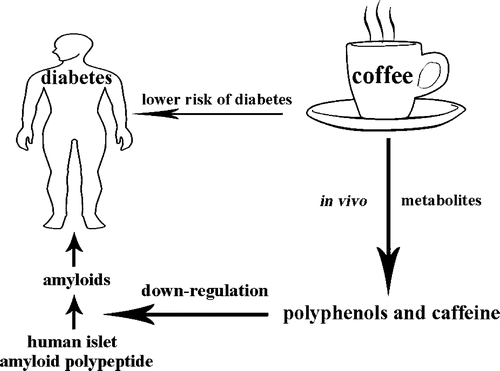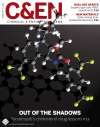
多喝咖啡防治糖尿病的示意图
最新发现与创新
近日从华中科技大学传出消息,该校同济医学院药学院黄昆教授带领的科研团队研究认为,长期每天饮用4杯左右的咖啡,可抑制体内有害的蛋白质变化,使糖尿病的患病几率减少50%。该项研究的成果作为美国化学学会“每周精选论文”,登上了其官方网站首页。
长期以来,已有人通过经验发现,饮用咖啡与糖尿病低发生率之间似乎存在一定联系,但饮用咖啡能够降低糖尿病患病率的机制仍不清楚。黄昆等人的研究发现,咖啡中有两种有效活性成分,能够抑制胰脏中一种导致糖尿病的蛋白质的有害变化,多饮用咖啡对糖尿病的治疗和预防都可能有一定作用。其研究还表明,咖啡中含量很高的咖啡因的抗糖尿病活性很低,综合考虑下,多饮用脱咖啡因咖啡效果应该更好。
去年底,黄昆等在美国化学会旗下期刊《农业与食品化学》杂志发表论文“咖啡主要成份抑制人胰淀素的有害聚集:咖啡饮用与糖尿病发病率的联系”,正式提出了这一“见解”。美国合众国际社在报道中称:“该研究结果可能首次解释为什么经常饮用咖啡能够降低糖尿病患病率。”法新社的报道也称:“中国科学家可能发现了咖啡降低糖尿病发生率的真正机理。”
2月23日,黄昆在接受采访时表示,很多人在饮用咖啡时喜欢加入大量的糖、奶或者咖啡伴侣,而这些对糖尿病都有一定的负效应,因此,建议尽量饮用无糖、无奶无脂肪的黑咖啡;此外,咖啡中一个抗糖尿病活性非常强的成分在绿茶中的含量也较丰富,常饮用绿茶或许也可以达到抑制糖尿病的效果。
黄昆主要从事代谢疾病及相关创新生物技术药物研究,2008年初从美国回国到华中科技大学工作。目前,黄昆的研究团队正以该研究为基础,开展新型抗糖尿病药物的研发。

 Coffee Components Inhibit Amyloid Formation of Human Islet Amyloid Polypeptide in Vitro: Possible Link between Coffee Consumption and Diabetes Mellitus
Coffee Components Inhibit Amyloid Formation of Human Islet Amyloid Polypeptide in Vitro: Possible Link between Coffee Consumption and Diabetes Mellitus
Biao Cheng, Xinran Liu, Hao Gong, Lianqi Huang, Hong Chen, Xin Zhang, Chuanzhou Li§, Muyang Yang, Bingjun Ma, Lihua Jiao, Ling Zheng, and Kun Huang
Global epidemic studies have suggested that coffee consumption is reversely correlated with the incidence of type 2 diabetes mellitus (T2DM), a metabolic disease. The misfolding of human islet amyloid polypeptide (hIAPP) is regarded as one of the causative factors of T2DM. Coffee extracts have three major active components: caffeine, caffeic acid (CA), and chlorogenic acid (CGA). In this study, the effects of these major coffee components, as well as dihydrocaffeic acid (DHCA) (a major metabolite of CGA and CA), on the amyloidogenicity of hIAPP were investigated by thioflavin-T based fluorescence emission, transmission electronic microscopy, circular dichroism, light-induced cross-linking, dynamic light scattering, and MTT-based cell viability assays. The results suggest that all components show varied inhibitory effects on the formation of toxic hIAPP amyloids, in which CA shows the highest potency in delaying the conformational transition of the hIAPP molecule with the most prolonged lag time, whereas caffeine shows the lowest potency. At a 5-fold excess molar ratio of compound to hIAPP, all coffee-derived compounds affect the secondary structures of incubated hIAPP as suggested by the circular dichroism spectra and CDPro deconvolution analysis. Further photoinduced cross-linking based oligomerization and dynamic light scattering studies suggested CA and CGA significantly suppressed the formation of hIAPP oligomers, whereas caffeine showed no significant effect on oligomerization. Cell protection effects were also observed for all three compounds, with the protection efficiency being greatest for CA and least for CGA. These findings suggest that the beneficial effects of coffee consumption on T2DM may be partly due to the ability of the major coffee components and metabolites to inhibit the toxic aggregation of hIAPP.







